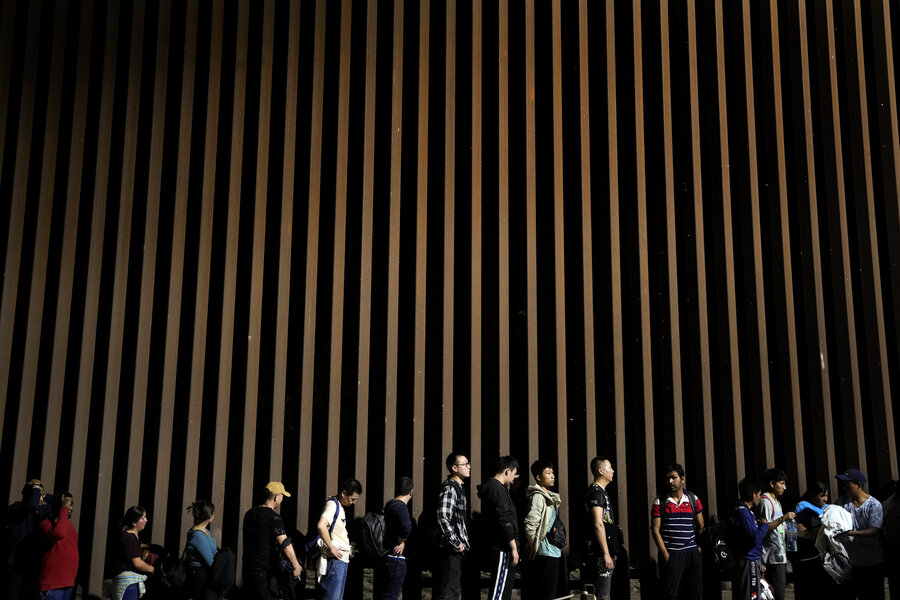Border battle: Court backs Biden administration’s asylum limit
Loading...
| Washington
An appeals court Thursday allowed a rule restricting asylum at the southern border to temporarily stay in place. The decision is a major win for the Biden administration, which had argued that the rule was integral to its efforts to maintain order along the United States-Mexico border.
The new rule makes it extremely difficult for people to be granted asylum unless they first seek protection in a country they’re traveling through on their way to the U.S. or apply online. It includes room for exceptions and does not apply to children traveling alone.
The decision by the U.S. 9th Circuit Court of Appeals grants a temporary reprieve from a lower court decision that had found the policy illegal and ordered the government to end its use by this coming Monday. The government had gone quickly to the appeals court asking for the rule to be allowed to remain in use while the larger court battles surrounding its legality play out.
The three-judge panel ruled 2-1 in favor of the government’s request. They also said they would expedite the hearing for the appeal with both sides expected to send in their arguments to the court by mid-September and a hearing to be held at an unspecified date, meaning a relatively fast timeline to review the case.
Judges William Fletcher and Richard Paez, who were both appointed by President Bill Clinton, ruled in favor of the stay but gave no reason for their decision. Judge Lawrence VanDyke, who was appointed by President Donald Trump, dissented. In his dissent, Mr. VanDyke seemed to agree with the legality of the rule in theory but said it was little different than previous rules put forward by the Trump administration that were shot down by the same appeals court when Mr. Trump was in office. He suggested that the judges had been moved to grant the stay because they feared that if the case went all the way to Supreme Court, that body would have done it instead.
“I wish I could join the majority in granting a stay. It is the right result. But that result, right as it may be, isn’t permitted by the outcome-oriented mess we’ve made of our immigration precedent,” Mr. VanDyke wrote.
The new asylum rule was put in place back in May. At the time, the U.S. was ending the use of a different policy called Title 42, which had allowed the government to swiftly expel migrants without letting them seek asylum. The stated purpose was to protect Americans from the coronavirus.
The administration was concerned about a surge of migrants coming to the U.S. post-Title 42 because the migrants would finally be able to apply for asylum. The government said the new asylum rule was an important tool to control migration.
Rights groups sued, saying the new rule endangered migrants by leaving them in northern Mexico as they waited to score an appointment on the CBP One app the government is using to grant migrants the opportunity to come to the border and seek asylum. The groups argued that people are allowed to seek asylum regardless of where or how they cross the border and that the government app is faulty. They also argue that the new asylum rule is essentially a reboot of two previous rules put forward by Mr. Trump that sought to limit asylum – the same point Mr. VanDyke alluded to in his dissent.
One of the groups, the American Civil Liberties Union, noted in a news release Thursday that the ruling didn’t weigh the legality of the asylum rule and that they were confident they’d ultimately prevail.
“We are pleased the court placed the appeal on an expedited schedule so that it can be decided quickly, because each day the Biden administration prolongs its efforts to preserve its illegal ban, people fleeing grave danger are put in harm’s way,” said the ACLU’s Katrina Eiland, who argued the case.
The groups also have argued that the government is overestimating the importance of the new rule in controlling migration. They say that when the U.S. ended the use of Title 42, it went back to what’s called Title 8 processing of migrants. That type of processing has much stronger repercussions for migrants who are deported, such as a five-year bar on reentering the U.S. Those consequences – not the asylum rule – were more important in stemming migration after May 11, the groups argue.
“The government has no evidence that the Rule itself is responsible for the decrease in crossings between ports after Title 42 expired,” the groups wrote in court briefs.
But the government has argued that the rule is a fundamental part of its immigration policy of encouraging people to use lawful pathways to come to the U.S. and imposing strong consequences on those who don’t. The government stressed the “enormous harms” that would come if it could no longer use the rule.
“The Rule is of paramount importance to the orderly management of the Nation’s immigration system at the southwest border,” the government wrote.
The government also argued that it was better to keep the rule in place while the lawsuit plays out in the coming months to prevent a “policy whipsaw” whereby Homeland Security staff process asylum seekers without the rule for a while only to revert to using it again should the government ultimately prevail on the merits of the case.
In a statement Thursday, the Department of Homeland Security credited the rule with significantly reducing irregular migration.
“To be clear, we will continue to apply the rule and immigration consequences for those who do not have a lawful basis to remain in the United States,” the agency said. “We encourage migrants to ignore the lies of smugglers and use lawful, safe, and orderly pathways.”
This story was reported by The Associated Press.





